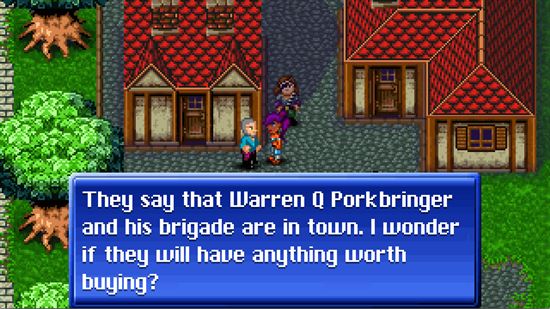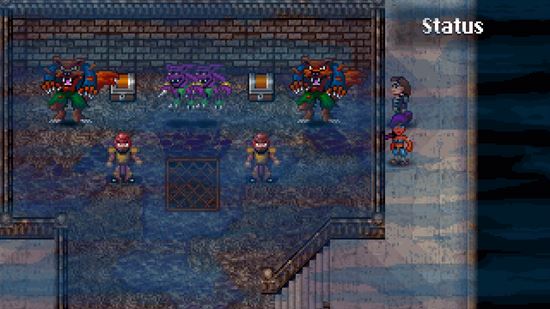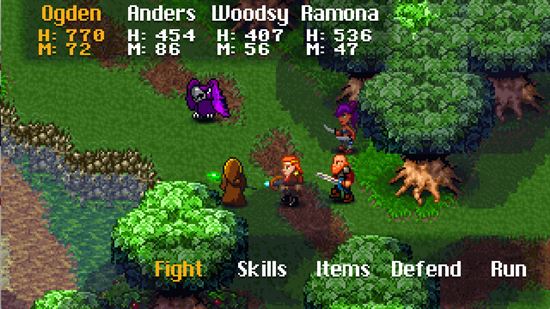Also On: PSN for PS3
Publisher: Muteki Corporation
Developer: Muteki Corporation
Medium: Digital
Players: 1
Online: Cross-Save
ESRB: E10+
I’ve never thrown a controller before. I’m not saying that to brag (because that’s not really brag-worthy), or to show off my skills (because I usually play games on the easiest difficulty). Rather I’m saying it to give some context for this next sentence: I hated Dragon Fantasy Book II so much I almost threw my Vita in frustration.
I didn’t of course, because I can’t imagine tossing a piece of semi-expensive technology across a room. But still: there was a point in the game where I was so annoyed by what was happening onscreen that my instinctive gut reaction was to fling my Vita down on the ground. The only thing that stopped me was the abrupt realization that…well, that I was so angry I was ready to throw my Vita.
My reason for being frustrated was simple: Dragon Fantasy Book II is a mind-numbingly repetitive game with an absolutely atrocious combat system. Or, to be more specific, half an hour into the game I was pissed off that I was being forced to engage in combat for what seemed like the thirtieth or fortieth time against enemies I’d already vanquished at least a half-dozen times before.
Really, that sentence contains everything wrong with Dragon Fantasy II, so I’ll break it down a little. First, the enemies: they’re freaking everywhere. You’d think this would count as an improvement over the first game, since in that game all the enemy encounters were randomly scattered across the map, but it’s not. Here, you come onto a new screen, and you’re almost instantly besieged on all sides. Even if you’ve already defeated them, there doesn’t seem to be any rhyme or reason to their respawning; I lost track the number of times I’d go from section to the next and then return, only to find that the rocks/goblins/fishes/whatever I’d just killed had all come back.
This is particularly a problem, of course, because every single battle takes so insanely long to get through. You see, apart from the first couple of minutes (when many of the battles are solo), almost all the battles here involve large groups of combatants taking part in turn-based combat with opponents who take more than one hit to kill. This means that every single battle — which, again, happen frequently because the same monsters are everywhere — requires you to first go through each of your characters to select moves, then to watch as your opponents each do their moves, and then you actually do your moves, and then you pick more moves, and so on. On top of that, most of the time you’re fighting monsters in large groups, because they’re hyper-aggressive and instantly gravitate to you the moment you move on to a new part of the map. You can try running, but even then you need to select “Run” for each party member, and then you wait until your opponents have all made their moves before you actually do try and make a run for it. Of course, running is kind of futile, since even if you successfully run away on your first try, you’ll quickly find your escape to be short-lived — after all, you’re surrounded, which means that even if you run from one monster you’re still running towards another.
This means that fighting is usually your only option — but this, too, has its downfalls. First off, each turn-based battle features a ridiculous amount of misses. The upside, I guess, is that both sides are prone to missing, but that doesn’t make it any less absurd to watch when all of your party members whiff on their attacks, and then most of your seven or eight opponents miss too. And when you do make contact, there’s not really any way of knowing how effective your attacks have been, since the game doesn’t give a health meter for your opponents. In other words, you just hack and hack and hack, and hope that, at some point, it’s enough to finish the other group off.
And if you do win your battle? Then you get to see the same “funny” lines repeated ad nauseum. Now, in the first game this was kind of a highlight, since the writing was funny and unexpected — though, to be sure, it was a case of diminishing funny returns, as what was funny the first few times was significantly less so by the 50th. Here, by contrast, you don’t even have that; the lines feel played-out at the beginning, and are a little rage-inducing by the tenth (to say nothing of the thirthieth, fortieth, fiftieth, etc.). There’s some mildly witty dialogue that takes place between your character and those in the cities/towns/villages, but it’s outweighed by the sheer volume of repeated laugh lines in the battles.
What makes the game totally unpalatable, though, is that Dragon Fantasy Book II doesn’t even have the audio-visual charm of Book I (our review here). That game showed off the talents of some guys who not only knew how to be funny (at least in small doses), but who clearly loved the looks, sounds and gameplay 8-bit and 16-bit RPGs of their youths, and were able to recreate their experiences pretty flawlessly. This time out, they’ve updated their points of reference a little — think really high-end 16-bit graphics, but with significantly better music — but it’s nowhere near as charming. Time and again, I found myself comparing Books I and II, and the latter came out worse for wear every single time.
At this point, I’d love to be able to say something positive to counteract all this negativity. I’d love to point to something — anything — redeeming about the game. But I can’t do it. Dragon Fantasy Book II was tedious at the absolute best of times. At worst, it made me seriously consider breaking my longstanding personal prohibition against smashing my electronics. Recent price cut or not, that’s not an option that anyone should take seriously, so you’re better off just ignoring this game entirely and saving yourself from a world of aggravation.




